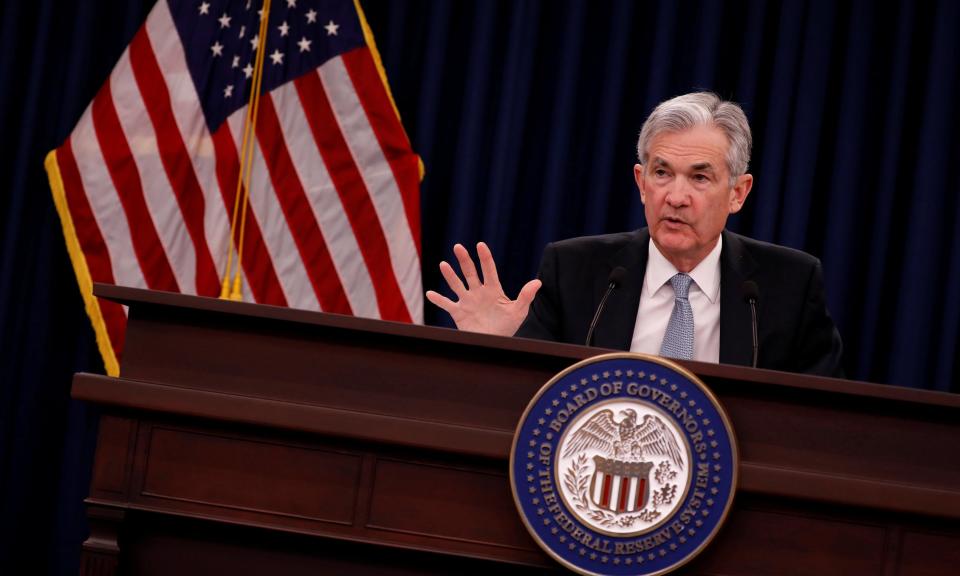The Fed's big message to markets — don't worry about our forecasts
The Federal Reserve does not want markets to fixate on its forecasts.
On Wednesday, the Fed raised interest rates for the sixth time since the financial crisis, bringing the target range on its benchmark interest rate to a band of 1.5%-1.75%. This move makes the effective fed funds rate 1.63%, the highest since September 2008. The Fed also released its latest Summary of Economic Projections (SEP), a set of forecasts from Fed officials about where interest rates, economic growth, inflation, and the unemployment rate will be in the future.
But in his inaugural post-FOMC meeting press conference since being confirmed as Fed Chair, Jerome Powell sought to downplay the market’s fixation on its latest dot plot and this chart’s implication that interest rates will rise above their long-run equilibrium rate by 2020.
“The summary of economic projections is really a compilation of the individual rate forecasts,” Powell said. “The Committee made one decision at this meeting. And that was to raise the federal funds rate by 25 basis points. The summary of economic projections is individual forecasts compiled and written down.”

“It could change up, it could change down”
Powell later added following another question about the Fed’s dot plot that, “I think, like any set of forecasts, those forecasts will change over time. And they’ll change depending on the way the outlook for the economy changes. It could change up, it could change down.”
The Fed’s latest SEP showed that the median interest rate forecast among Fed officials called for rates to rise at least two more times this year, three more times in 2019, and twice more in 2020.
Rates following this path would bring the effective fed funds rate to around 3.4%, above the 3% that Fed officials expect will be needed to sustain full employment and 2% price inflation over the long term.

The Fed’s forecasts also showed committee members expect the economy growing faster in 2018 and 2019 as a result of the tax cuts passed by the Trump administration in late 2017. In its policy statement the Fed added a sentence which said, “The economic outlook has strengthened in recent months.”
GDP growth in 2018 is now expected to hit 2.7%, up from 2.5% in its December forecasts and an increase from a forecast for 2.1% growth this year in the March 2017 set of forecasts. In 2019, the Fed now sees the economy growing 2.4%, up from 2.1% in its December forecast.
“Powell took pains to point out the shortcomings of the SEP,” said Seth Carpenter, an economist at UBS in a note following the Fed’s announcement on Wednesday.
“First, he highlighted, that the only decision the FOMC took was the increase in the target rate. Second, the median is interesting, but not the whole story. The takeaway is that Powell was actively talking down the relevance of the SEP, especially the median itself.
“In response to a question about what could cause the Committee to hike four times this year instead of the three dots, Powell dismissed the signal in the three hikes in the median dot, saying that the FOMC could do more or less if the outlook changes. He was saying that people pay too much attention to the dots.”
Putting off the inevitable?
Some Wall Street economists, however, see Powell’s downplaying of the clearly more hawkish future of the Federal Reserve as something like putting off the inevitable.
“The Fed now anticipates that rates will have to be raised significantly beyond their neutral level in order to limit the rise in inflation over the coming years,” said Michael Pearce, senior US economist at Capital Economics
“In the post-meeting press conference, Jerome Powell played down this risk, saying the economy was ‘not on the cusp’ of a significant rise in price pressures. We think officials are underestimating how quickly inflation will rise, which is why we still expect the Fed will ultimately be forced to raise rates four times this year.”
A close read of the Fed’s longer-term economic outlook for slightly increasing inflation, flat unemployment, and slowing economic growth, perhaps reveals the outlines of a Fed looking towards the end of the economic expansion. But with the pains taken by the new Fed Chair to de-emphasize the certainty of these forecasts, markets are largely left only knowing, for sure, that interest rates are now higher than they were on Tuesday and likely to be increased at least twice more this year.
“Powell’s first press conference was crisp, uncontroversial, and perhaps even a bit boring—which may count as a success,” said Michael Feroli, an economist at JP Morgan.
“Powell downplayed the interest rate forecasts by stressing their conditionality. Powell judiciously avoided saying anything controversial or informative about their thinking on tariffs. He also artfully dodged questions on the supply-side effects of recent fiscal actions. The downside of a gaffe-less press conference is that there wasn’t a whole lot of new information about how the Committee is seeing things.”
—
Myles Udland is a writer at Yahoo Finance. Follow him on Twitter @MylesUdland
Read more from Myles here:
A few major topics were missing from Warren Buffett’s latest annual letter
The Trump tax cut earned Warren Buffett’s Berkshire Hathaway $29 billion in 2017
Goldman Sachs says U.S. economic data right now is ‘as good as it gets’
One candidate for Amazon’s next headquarters looks like a clear frontrunner
